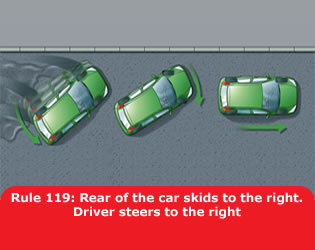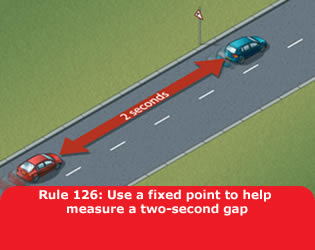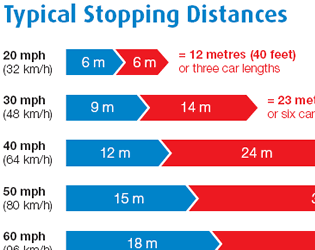Braking
- 117
In normal circumstances. The safest way to brake is to do so early and lightly. Brake more firmly as you begin to stop. Ease the pressure off just before the vehicle comes to rest to avoid a jerky stop.
- 118
In an emergency. Brake immediately. Try to avoid braking so harshly that you lock your wheels. Locked wheels can lead to loss of control.
- 119
Skids. Skidding is usually caused by the driver braking, accelerating or steering too harshly or driving too fast for the road conditions. If skidding occurs, remove the cause by releasing the brake pedal fully or easing off the accelerator. Turn the steering wheel in the direction of the skid. For example, if the rear of the vehicle skids to the right, steer immediately to the right to recover.

- 120
ABS. If your vehicle is fitted with anti-lock brakes, you should follow the advice given in the vehicle handbook. However, in the case of an emergency, apply the footbrake firmly; do not release the pressure until the vehicle has slowed to the desired speed. The ABS should ensure that steering control will be retained, but do not assume that a vehicle with ABS will stop in a shorter distance.
- 121
Brakes affected by water. If you have driven through deep water your brakes may be less effective. Test them at the first safe opportunity by pushing gently on the brake pedal to make sure that they work. If they are not fully effective, gently apply light pressure while driving slowly. This will help to dry them out.
- 122
Coasting. This term describes a vehicle travelling in neutral or with the clutch pressed down. It can reduce driver control because
- engine braking is eliminated
- vehicle speed downhill will increase quickly
- increased use of the footbrake can reduce its effectiveness
- steering response will be affected, particularly on bends and corners
- it may be more difficult to select the appropriate gear when needed
- 123
The Driver and the Environment. You MUST NOT leave a parked vehicle unattended with the engine running or leave a vehicle engine running unnecessarily while that vehicle is stationary on a public road. Generally, if the vehicle is stationary and is likely to remain so for more than a couple of minutes, you should apply the parking brake and switch off the engine to reduce emissions and noise pollution. However it is permissible to leave the engine running if the vehicle is stationary in traffic or for diagnosing faults.
[Law CUR regs 98 & 107] Built-up areas *
Single carriage-ways
Dual carriage-ways
Motorways
Type of vehicle
mph (km/h)
mph (km/h)
mph (km/h)
mph (km/h)
Cars & motorcycles
(including car-derived vans up to 2 tonnes maximum laden weight)30 (48)
60 (96)
70 (112)
70 (112)
Cars towing caravans or trailers
(including car-derived vans and motorcycles)30 (48)
50 (80)
60 (96)
60 (96)
Buses, coaches and minibuses
(not exceeding 12 metres in overall length)30 (48)
50 (80)
60 (96)
70 (112)
Goods vehicles
(not exceeding 7.5 tonnes maximum laden weight)30 (48)
50 (80)
60 (96)
70 (112) **
Goods vehicles
(exceeding 7.5 tonnes maximum laden weight)30 (48)
40 (64)
50 (80)
60 (96)
The 30 mph limit usually applies to all traffic on all roads with street lighting unless signs show otherwise.
60 mph (96 km/h) if articulated or towing a trailer.
Speed limits
- 124
You MUST NOT exceed the maximum speed limits for the road and for your vehicle (see the table above). The presence of street lights generally means that there is a 30 mph (48 km/h) speed limit unless otherwise specified.
[Law RTRA sects 81, 86, 89 & sch 6]
- 125
The speed limit is the absolute maximum and does not mean it is safe to drive at that speed irrespective of conditions. Driving at speeds too fast for the road and traffic conditions is dangerous. You should always reduce your speed when
- the road layout or condition presents hazards, such as bends
- sharing the road with pedestrians, cyclists and horse riders, particularly children, and motorcyclists
- weather conditions make it safer to do so
- driving at night as it is more difficult to see other road users

- 126
Stopping Distances. Drive at a speed that will allow you to stop well within the distance you can see to be clear. You should
- leave enough space between you and the vehicle in front so that you can pull up safely if it suddenly slows down or stops. The safe rule is never to get closer than the overall stopping distance (see Typical Stopping Distances PDF below)
- allow at least a two-second gap between you and the vehicle in front on roads carrying faster-moving traffic and in tunnels where visibility is reduced. The gap should be at least doubled on wet roads and increased still further on icy roads
- remember, large vehicles and motorcycles need a greater distance to stop. If driving a large vehicle in a tunnel, you should allow a four-second gap between you and the vehicle in front

 Buy Gifts Vouchers Here
Buy Gifts Vouchers Here Intensive Driving Courses
Intensive Driving Courses Driving Test Booking Services
Driving Test Booking Services


